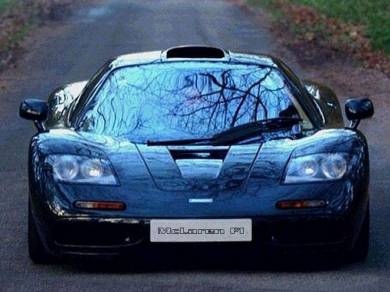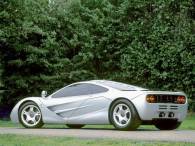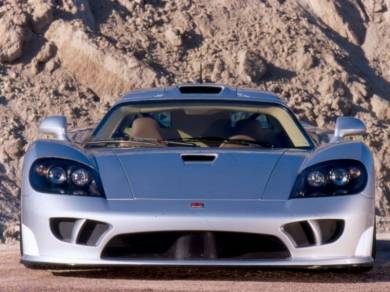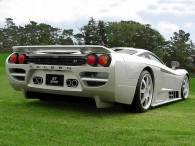McLaren F1

In 1993, ex-Formula 1 grease monkey Gordon Murray realised his long-time vision for the
ultimate supercar. Persuading BMW to make a unique engine just for his dream car, the final
result is a car powered by a high-revving 627 hp V12, clothed in the sleekest and lightest
of bodyworks and housing a unique driving position similar to a one-seater race car.
Limited to only a 100 specimens, a quarter of which were racing versions, this million-
dollar car only goes up in value.
 Penned by celebrity designer Peter Stevens, the carbon fiber body is small on the
outside, but actually houses an amazing three people - a driver and two passengers. No
other supercar can yet claim to do so. Build quality is excellent, with opening
compartments around the car that can hold small amounts of luggage. The central driving
position is hard to get into, but makes for ideal weight distribution, plus allows two
passengers on either side, some way behind the driver. The Ameritech US-spec version has
some bodywork enhancements to pass NHTSA crash tests, but it is also slower than the
original European model. Other versions include the rare F1 LM, race-spec F1 GTR and
revised F1 GT.
Penned by celebrity designer Peter Stevens, the carbon fiber body is small on the
outside, but actually houses an amazing three people - a driver and two passengers. No
other supercar can yet claim to do so. Build quality is excellent, with opening
compartments around the car that can hold small amounts of luggage. The central driving
position is hard to get into, but makes for ideal weight distribution, plus allows two
passengers on either side, some way behind the driver. The Ameritech US-spec version has
some bodywork enhancements to pass NHTSA crash tests, but it is also slower than the
original European model. Other versions include the rare F1 LM, race-spec F1 GTR and
revised F1 GT.
The 6.1L V12 engine, developed by BMW's M Power division exclusively for the McLaren, is
rev-limited to 7500 rpm in stock form. Made up magnesium, aluminum and carbon fiber bits to
save weight, it even has gold spread out on the engine as a heat resistant material. The
627 hp, though, is a little excessive for the chassis, so handling is not as good as, say,
a Ferrari F50. Abundant in technology such as fan-assisted ground effects and retractable
rear spoiler, it lacks some basics such as ABS.
The first McLaren underwent high-speed testing in 1993, breaking the Jag's street-legal
top speed record, with a figure of 231 mph using a pre-production 585 hp engine. Five years
later, a proper production model, with a disabled rev-limiter allowing the engine to rev to
7800 rpm, officially clocked up 240 mph, which remains unbeaten. Moreover, the F1 can speed to 200 mph in only 28 seconds, which is proving hard to beat.
Saleen S7

Saleen is a well-known American tuner famous for its upgraded Ford Mustangs. But now
they've gone one-up and built their own car from scratch - the S7. Debuting in 2001, it is dubbed America's first true supercar, bypassing Corvettes and Vipers to compete with the fastest exotic cars on the road today, capabale of speeds in excess of 200 mph. According to their hype, its ground effects are so extreme that the S7 can be driven upside down at 160 mph and still stay glued to the tarmac. Amazingly, it only took 18 months to develop this car, which will have an estimated production run of between 300 and 400 cars over four years.
 Saleen's usual design guru, Phil Frank, digitally drew up the exterior design, influenced heavily by the engineering department's wind tunnel tests. Underside aerodynamics and functional scoops al over the body optimize airflow around the car, keeping it stable at high speeds. Even the driver's seat is moved slightly towards the center of the car for optimal weight distribution. The car can hold luggage at the front and back due its mid-engine layout, and the interior has common creature comforts like a CD changer and power windows. In a step up from other exotics, the S7 employs video cameras instead of rear view mirrors, thus eliminating the need to remove any mirrors during top speed runs in a bid to reduce drag.
Saleen's usual design guru, Phil Frank, digitally drew up the exterior design, influenced heavily by the engineering department's wind tunnel tests. Underside aerodynamics and functional scoops al over the body optimize airflow around the car, keeping it stable at high speeds. Even the driver's seat is moved slightly towards the center of the car for optimal weight distribution. The car can hold luggage at the front and back due its mid-engine layout, and the interior has common creature comforts like a CD changer and power windows. In a step up from other exotics, the S7 employs video cameras instead of rear view mirrors, thus eliminating the need to remove any mirrors during top speed runs in a bid to reduce drag.
The Saleen S7's 7.0L naturally aspirated engine is based on Ford's all-so-common V8 workhorse, but it is all-aluminum in this application, with a larger displacement and shorter overall length. Although the 550 hp fed to the rear wheels is less than the McLaren F1's 627 hp, the V8 produces more torque - 520 lb-ft compared to the F1's 479 lb-ft. Initial acceleration figures are excellent, easily keeping up with an Ameritech F1, but top end grunt is another story. Even a Viper SRT-10 can catch up to the S7 at around the 100 mph mark. The new Viper can stop quicker too, since the S7 has no ABS. In the Saleen's defence, a Viper tops out at just above 190 mph, while the S7 can keep on going well past that mark.
So can this lightweight American challenge the top speed crown? Sadly, the S7 has never undergone high speed tests, but even in theory, the car is expected to top out at 220 mph - better than the 1992 uber-Jag, tying the latest iteration of the 7.3L Pagani Zonda, but not even close to the Big Mac. But heck, it's only two-thirds the cost of a Ferrari Enzo and one-third the cost of the F1.
Continue...
Page 1 2 3 4